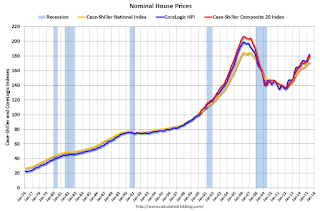by Calculated Risk on 7/28/2015 01:11:00 PM
Tuesday, July 28, 2015
Real Prices and Price-to-Rent Ratio in May
A great discussion from Nick Timiraos at the WSJ: Are Home Prices Again Breaking Records? Not Really
The National Association of Realtors‘ monthly home sales report made a big splash last week with news that median home prices in June had broken the record set in 2006 at the peak of the housing bubble, reaching a nominal high of $236,400.The price-to-rent does seem a little high (last graph below), but the speculation associated with a bubble isn't present. No worries.
Does this mean we have another problem on our hands? Not really.
...[see data and graphs]
...
There may be other reasons to worry about housing affordability by comparing prices with incomes or prices with rents for a given market. But crude comparisons of nominal home prices with their 2006 and 2007 levels shouldn’t be used to make cavalier claims about a new bubble.
The year-over-year increase in prices is mostly moving sideways now at a little over 4%. In October 2013, the National index was up 10.9% year-over-year (YoY). In May 2015, the index was up 4.4% YoY.
Here is the YoY change since last May for the National Index:
| Month | YoY Change |
|---|---|
| May-14 | 7.1% |
| Jun-14 | 6.3% |
| Jul-14 | 5.6% |
| Aug-14 | 5.1% |
| Sep-14 | 4.8% |
| Oct-14 | 4.7% |
| Nov-14 | 4.6% |
| Dec-14 | 4.6% |
| Jan-15 | 4.4% |
| Feb-15 | 4.3% |
| Mar-15 | 4.2% |
| Apr-15 | 4.3% |
| May-15 | 4.4% |
Most of the slowdown on a YoY basis is now behind us (I don't expect price to go negative this year). This slowdown in price increases was expected by several key analysts, and I think it was good news for housing and the economy.
In the earlier post, I graphed nominal house prices, but it is also important to look at prices in real terms (inflation adjusted). Case-Shiller, CoreLogic and others report nominal house prices. As an example, if a house price was $200,000 in January 2000, the price would be close to $276,000 today adjusted for inflation (38%). That is why the second graph below is important - this shows "real" prices (adjusted for inflation).
It has been almost ten years since the bubble peak. In the Case-Shiller release this morning, the National Index was reported as being 7.6% below the bubble peak. However, in real terms, the National index is still about 21% below the bubble peak.
Nominal House Prices
 The first graph shows the monthly Case-Shiller National Index SA, the monthly Case-Shiller Composite 20 SA, and the CoreLogic House Price Indexes (through March) in nominal terms as reported.
The first graph shows the monthly Case-Shiller National Index SA, the monthly Case-Shiller Composite 20 SA, and the CoreLogic House Price Indexes (through March) in nominal terms as reported.In nominal terms, the Case-Shiller National index (SA) is back to June 2005 levels, and the Case-Shiller Composite 20 Index (SA) is back to February 2005 levels, and the CoreLogic index (NSA) is back to April 2005.
Real House Prices
 The second graph shows the same three indexes in real terms (adjusted for inflation using CPI less Shelter). Note: some people use other inflation measures to adjust for real prices.
The second graph shows the same three indexes in real terms (adjusted for inflation using CPI less Shelter). Note: some people use other inflation measures to adjust for real prices.In real terms, the National index is back to June 2003 levels, the Composite 20 index is back to May 2003, and the CoreLogic index back to October 2003.
In real terms, house prices are back to 2003 levels.
Note: CPI less Shelter is down 1.6% year-over-year, so this is pushing up real prices.
Price-to-Rent
In October 2004, Fed economist John Krainer and researcher Chishen Wei wrote a Fed letter on price to rent ratios: House Prices and Fundamental Value. Kainer and Wei presented a price-to-rent ratio using the OFHEO house price index and the Owners' Equivalent Rent (OER) from the BLS.
 Here is a similar graph using the Case-Shiller National, Composite 20 and CoreLogic House Price Indexes.
Here is a similar graph using the Case-Shiller National, Composite 20 and CoreLogic House Price Indexes.This graph shows the price to rent ratio (January 1998 = 1.0).
On a price-to-rent basis, the Case-Shiller National index is back to March 2003 levels, the Composite 20 index is back to March 2003 levels, and the CoreLogic index is back to August 2003.
In real terms, and as a price-to-rent ratio, prices are mostly back to 2003 levels - and the price-to-rent ratio maybe moving a little sideways now.


